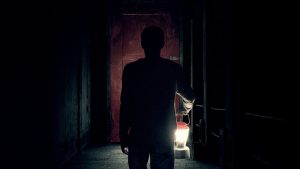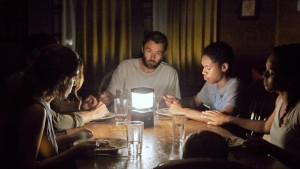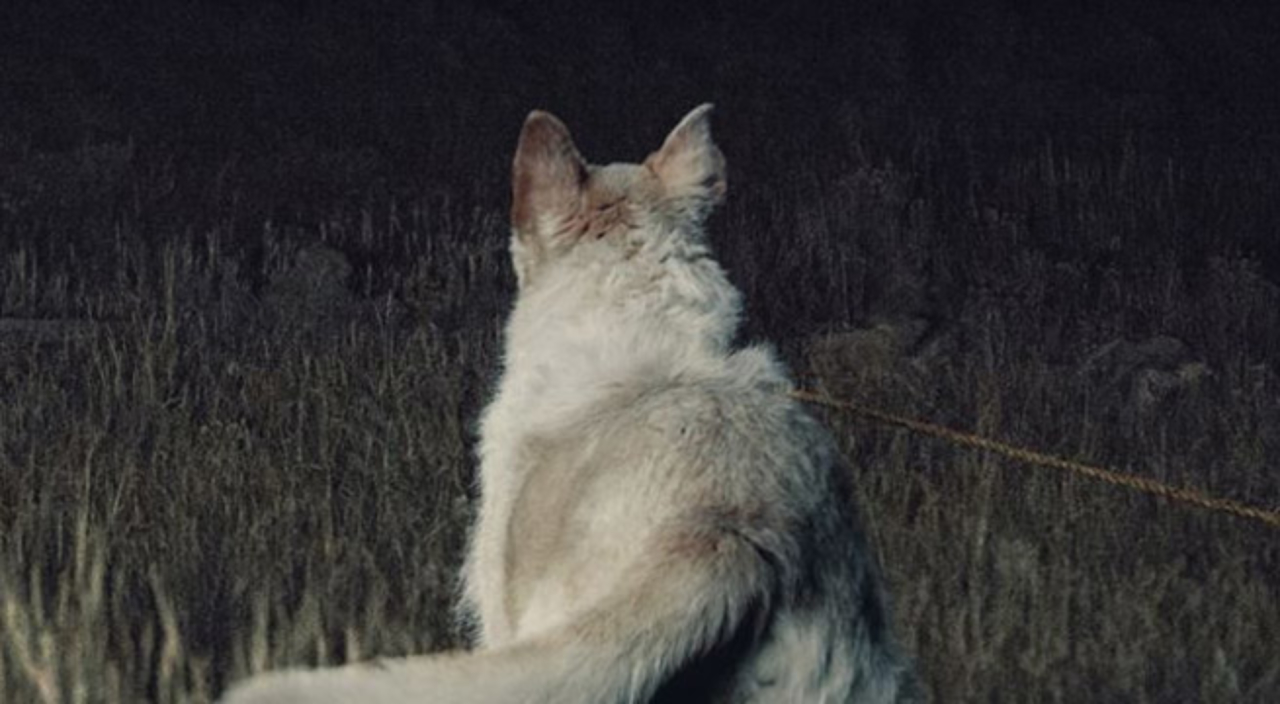Each time Travis (Kelvin Harrison Jr., Birth of a Nation) picks up his lantern to wander the dark halls of his family’s boarded up home, he strikes the image of a ghost- perhaps of a weary railroad conductor making his rounds. Tension builds with each creak of the floorboards, and the lengthening of shadows indicate that something ominous lurks. In his sophomore feature length effort, It Comes at Night, writer/director Trey Edward Shults proves sometimes less is more with horror. Sometimes, what we don’t see is as unsettling as actually revealing the monsters that hunt us.
The audience isn’t given a lot to work with in regard to world building. There is the aforementioned house and the surrounding woods. Nothing more is required. The presence of gas masks posit some sort of airborne virus exists, and the gruesome illness that has befallen Travis’ grandfather indicates said virus isn’t screwing around. Besides Travis, the house is occupied by his parents, Paul (Joel Edgerton, Loving) and Sarah (Carmen Ejogo, Alien: Covenant), and the family dog. Paul’s day-to-day routine is militaristic in nature- designed with safety and survival as priority.

When that safety is threatened, Paul is forced to make some uneasy decisions that will alter the dynamic he’s worked hard to sustain. The fly in the ointment here is Will (Christopher Abbott, Whiskey Tango Foxtrot), a survivor who attempts to break into the home in search of supplies for his family. Will eventually convinces Paul that his intentions are honest, and with some prodding from his own family, Paul consents to bring Will’s wife Kim (Riley Keough, American Honey), and young son Andrew (Griffin Robert Faulkner) to live in the house and share resources.
Shults keeps traditional horror tropes at arms length. He has no interest in burdening the audience with cheap jump scares or semi-visible ghoulies scurrying about. The tension in It Comes at Night stems from the atmosphere Shults has created. Most of the film is shrouded in a suffocating darkness- the fear of falling victim to the unseen virus keeping everyone on edge. Shults doubles down on the uneasiness through his characters’ interactions. Trust between the families is paper thin, and one sideways glance can send the new household dynamic into chaos.

Our perspective of this story comes primarily from Travis. The mood set by Harrison Jr.’s often unmoving gaze provides us a glimpse of a devolving world- a human condition that is gradually unraveling, fed by a lingering deceit and burgeoning mistrust. The graphic nightmares Travis endures, perhaps symbolic of the film’s title, show us a consequence of the withering psyche of Travis as an individual that’s clearly seen too much. Harrison Jr. sells all of it, and although we as the audience aren’t privy to any real context of what is happening in this world, the deconstructing of this one small segment of it is enough to earn our attention.
When we aren’t living in Travis’ worldview, the film treads along the interactions of Paul and Will. Edgerton and Abbott volley their mistrust of each other back and forth, threatening their uneasy alliance almost minute by minute. As an audience, we wait idly by for something to break. Both actors succeed in playing off each other’s skepticisms, but each is bound by a sense of personal duty to do right be their family. Alas, Ejogo and Keough serve little purpose beyond looking frightened and succumbing to direction from their men.

So what is Shults really playing at in It Comes at Night? Is the virus used as a macguffin to get at a more intimate portrait of social constructs? Does it really matter whether any of the characters fall victim to unseen horrors when the clear and present danger presents itself within their own interactions? A lot of time is spent worrying about what lies on the other side of a creepy red door, when the true horrors may reside on the same side as the people who are doing the worrying.
No doubt there are people who will walk away confused, or perhaps even angry. It’s a consequence of ambiguity. The ending is not conducive to filmgoers needing answers, but that doesn’t mean answers can’t be had. Monsters don’t always need to be tangible things with sharp teeth and fangs. But just because we can’t always see them doesn’t mean they aren’t there. Paranoia is a big motivator, and it hangs like a thick fog over this story. How you reconcile the themes within the film, and especially the ending, probably depends on the way your own life mirrors certain aspects within- the losses you’ve been dealt- the people you’ve had interactions with. It Comes at Night dares to play with those subconscious thoughts and invites you to explore them for yourself. Sometimes the true horrors lie within us.
Rating:


